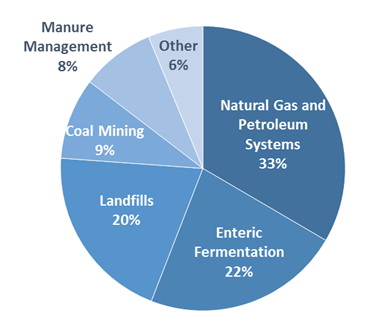While Congress is attempting to roll back a federal regulation on methane emissions, the California Air Resources Board approved a landmark rule that regulates methane emissions from onshore and offshore oil and gas production and storage facilities.

"While the federal government may be going backwards, California is going to be moving forwards,” Tim O’Connor, director of the California oil and gas program at the Environmental Defense Fund, told reporters in a conference call Wednesday, reported Rob Nikolewski for the Union-Tribune.
On the federal level, O'Connor was referring to the use of the Congressional Review Act to "overturn an Obama drilling rule" to limit the venting and flaring of methane emissions on federal lands. [More information at end of post.]
On the state level, he was referring to agenda item #17-3-6 (pdf) at Thursday's California Air Resources Board meeting.
"California air quality officials have approved what are widely considered to be the most rigorous and comprehensive regulations in the country for controlling methane emissions, a move that helps cement the state’s status as a standard-bearer for environmental protection," reports Dominic Fracassa for the San Francisco Chronicle. The rule, "Greenhouse Gas Emission Standards for Crude Oil and Natural Gas Facilities" (pdf) "seek(s) to curb methane emissions at oil and gas production plants by up to 45 percent over the next nine years."
Methane as a greenhouse gas
Critics of the rule were quick to note that the oil and gas industry is not the largest emitter of the second most prevalent greenhouse gas, pound for pound about 25 times greater than CO2 over a 100-year period, according to the U.S. Environmental Protection Agency. According the the pie chart on page 5 of the CARB presentation (pdf), agriculture is responsible for 58 percent, followed by landfills at 20 percent, pipelines at 9 percent, and oil and gas extraction and storage at 4 percent.
“Our industry is not the top emitter of methane in the state, yet this rule will add to the nation’s toughest regulations that our operators must follow, such as cap and trade,” Rock Zierman, the chief executive officer of industry trade group the California Independent Petroleum Association, said in a statement. “We hope that regulators will provide ample time for implementation and ensure that the program is fairly and consistently enforced across the state.”

On a national level, U.S. methane emissions, by source. (Source EPA. All emission estimates from the Inventory of U.S. Greenhouse Gas Emissions and Sinks: 1990-2014.)
Federal Methane Emissions rule
A few final notes on the federal attempt to rescind the aforementioned rule on venting and flaring of methane from oil and natural gas drilling sites on federal and Indian lands. On Feb 3, the House passed a resolution (H.J.Res.36) to reverse the Department of Interior's Methane and Waste Prevention Rule. E&E News reports on March 22 that Senate Environment and Public Works Chairman John Barrasso (R-Wyo.) has encountered difficulties in rounding up votes for their resolution, S.J. Res. 11.
[P]roponents of the measure say that with two GOP senators — Maine's Susan Collins and South Carolina's Lindsey Graham — expected to oppose it, the margin of error is razor thin.
FULL STORY: California passes nation’s toughest methane emission regulations

Planetizen Federal Action Tracker
A weekly monitor of how Trump’s orders and actions are impacting planners and planning in America.

Chicago’s Ghost Rails
Just beneath the surface of the modern city lie the remnants of its expansive early 20th-century streetcar system.

Amtrak Cutting Jobs, Funding to High-Speed Rail
The agency plans to cut 10 percent of its workforce and has confirmed it will not fund new high-speed rail projects.

Ohio Forces Data Centers to Prepay for Power
Utilities are calling on states to hold data center operators responsible for new energy demands to prevent leaving consumers on the hook for their bills.

MARTA CEO Steps Down Amid Citizenship Concerns
MARTA’s board announced Thursday that its chief, who is from Canada, is resigning due to questions about his immigration status.

Silicon Valley ‘Bike Superhighway’ Awarded $14M State Grant
A Caltrans grant brings the 10-mile Central Bikeway project connecting Santa Clara and East San Jose closer to fruition.
Urban Design for Planners 1: Software Tools
This six-course series explores essential urban design concepts using open source software and equips planners with the tools they need to participate fully in the urban design process.
Planning for Universal Design
Learn the tools for implementing Universal Design in planning regulations.
Caltrans
City of Fort Worth
Mpact (founded as Rail~Volution)
City of Camden Redevelopment Agency
City of Astoria
City of Portland
City of Laramie



























